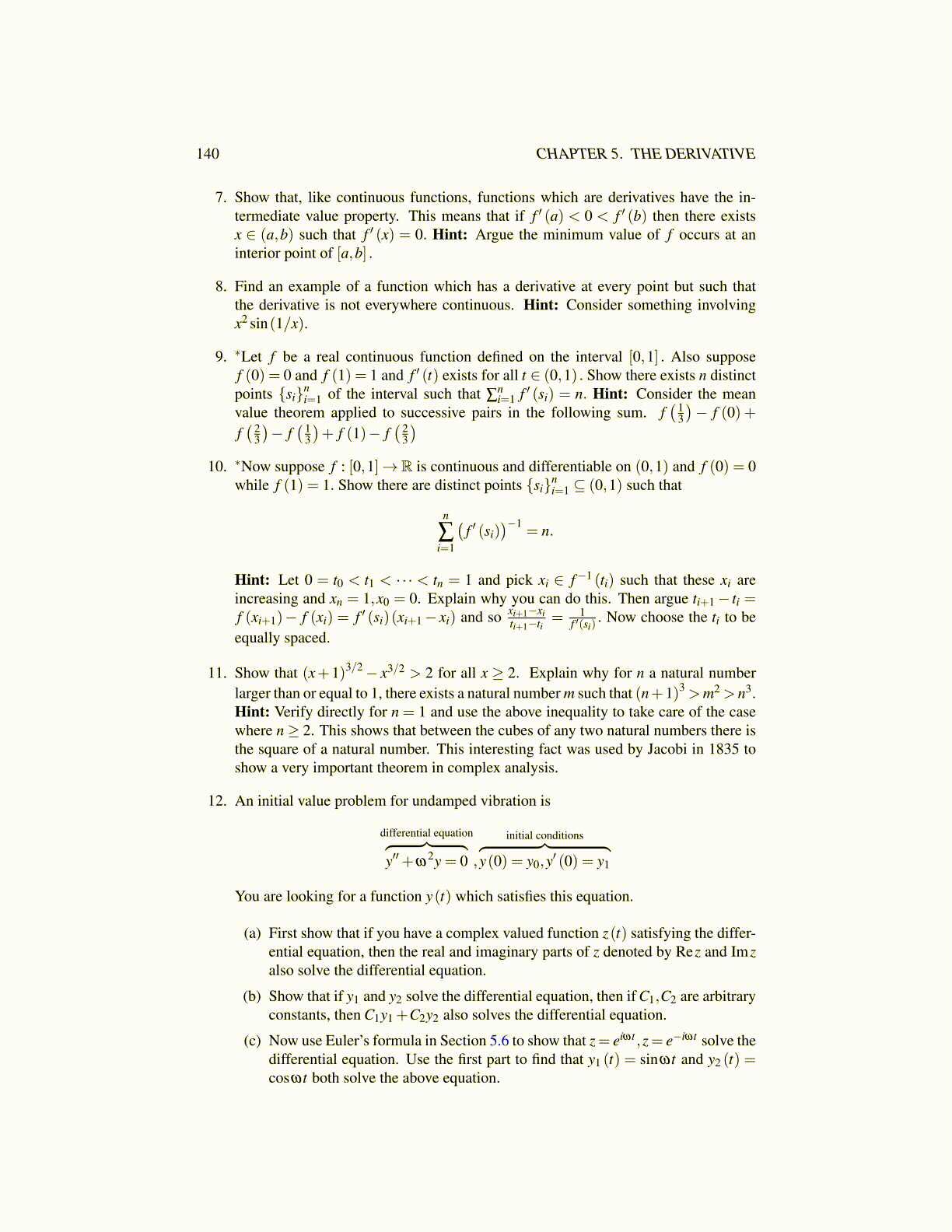
140 CHAPTER 5. THE DERIVATIVE
7. Show that, like continuous functions, functions which are derivatives have the in-termediate value property. This means that if f ′ (a) < 0 < f ′ (b) then there existsx ∈ (a,b) such that f ′ (x) = 0. Hint: Argue the minimum value of f occurs at aninterior point of [a,b] .
8. Find an example of a function which has a derivative at every point but such thatthe derivative is not everywhere continuous. Hint: Consider something involvingx2 sin(1/x).
9. ∗Let f be a real continuous function defined on the interval [0,1] . Also supposef (0) = 0 and f (1) = 1 and f ′ (t) exists for all t ∈ (0,1) . Show there exists n distinctpoints {si}n
i=1 of the interval such that ∑ni=1 f ′ (si) = n. Hint: Consider the mean
value theorem applied to successive pairs in the following sum. f( 1
3
)− f (0) +
f( 2
3
)− f
( 13
)+ f (1)− f
( 23
)10. ∗Now suppose f : [0,1]→ R is continuous and differentiable on (0,1) and f (0) = 0
while f (1) = 1. Show there are distinct points {si}ni=1 ⊆ (0,1) such that
n
∑i=1
(f ′ (si)
)−1= n.
Hint: Let 0 = t0 < t1 < · · · < tn = 1 and pick xi ∈ f−1 (ti) such that these xi areincreasing and xn = 1,x0 = 0. Explain why you can do this. Then argue ti+1 − ti =f (xi+1)− f (xi) = f ′ (si)(xi+1 − xi) and so xi+1−xi
ti+1−ti= 1
f ′(si). Now choose the ti to be
equally spaced.
11. Show that (x+1)3/2 − x3/2 > 2 for all x ≥ 2. Explain why for n a natural numberlarger than or equal to 1, there exists a natural number m such that (n+1)3 >m2 > n3.Hint: Verify directly for n = 1 and use the above inequality to take care of the casewhere n ≥ 2. This shows that between the cubes of any two natural numbers there isthe square of a natural number. This interesting fact was used by Jacobi in 1835 toshow a very important theorem in complex analysis.
12. An initial value problem for undamped vibration is
differential equation︷ ︸︸ ︷y′′+ω
2y = 0 ,
initial conditions︷ ︸︸ ︷y(0) = y0,y′ (0) = y1
You are looking for a function y(t) which satisfies this equation.
(a) First show that if you have a complex valued function z(t) satisfying the differ-ential equation, then the real and imaginary parts of z denoted by Rez and Imzalso solve the differential equation.
(b) Show that if y1 and y2 solve the differential equation, then if C1,C2 are arbitraryconstants, then C1y1 +C2y2 also solves the differential equation.
(c) Now use Euler’s formula in Section 5.6 to show that z= eiωt ,z= e−iωt solve thedifferential equation. Use the first part to find that y1 (t) = sinωt and y2 (t) =cosωt both solve the above equation.